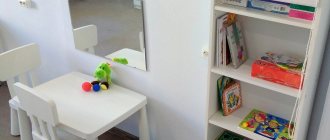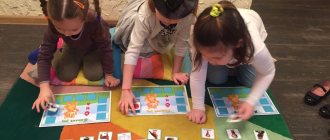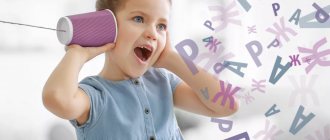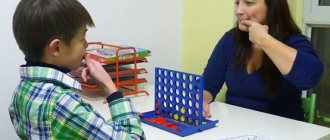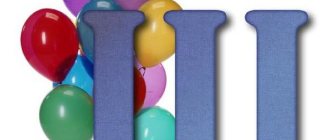The state of speech in children 4–5 years old can vary significantly. Some speak the language simply perfectly, others can only say something incomprehensible, pronouncing only a few words or making many mistakes in speech. In such cases, parents think about how to organize speech therapy classes for preschool children, what games and exercises will help them with speech development. After all, it is important to solve some problems before the child enters first grade.
Speech norms
You can understand how timely a child’s speech develops at this age based on the following guidelines.
- The main quality of speech of a 4–5 year old child is the ability to speak coherently and consistently.
- The child uses words in accordance with their meaning.
- His speech contains adjectives, pronouns, prepositions, including complex ones (due to, from under), adverbs.
- He knows how to control the strength and pace of his voice - speak softer, louder, whisper, slower, faster.
- Normal speech has the correct average tempo.
- A preschooler is able to fairly fully describe an object, toy, or picture.
- When telling a poem, the child actively uses intonation.
- Pronounces almost all sounds. Problems can only arise with [r] and [l], sometimes whistling and hissing ones continue to “sink”.
- The vocabulary at this age is approximately 3–4 thousand words, among which there are more and more adjectives denoting the qualities of objects, colors and shades; collective nouns appear.
- A child can begin to rhyme words, coming up with the most unimaginable constructions for rhyme (“fire” - a spark, “nikova” - no one’s).
- The baby is able to formulate sentences not only simple, but also complex (“I’m putting on a hat because it’s winter”; “I’m 4 years old, and my sister is already 7 years old”).
- Some grammatical errors are acceptable: incorrect agreement of words by gender and number, incorrect endings of verbs.
Finger games
Finger games are one of the types of development of fine motor skills. There is a close relationship between the human hand and the speech center of the brain.
Learning texts using “finger” gymnastics stimulates the development of speech, spatial thinking, attention, imagination, and develops reaction speed and emotional expressiveness. The child remembers poetic texts better; his speech becomes more expressive.
You need to exercise every day for 5 minutes, then such exercises will be effective.
When there's a problem
Unfortunately, not all children can boast of this level of speech development. It is especially difficult for those whose parents do not pay due attention to this aspect: they communicate little with the child, read little, do not teach poetry with him, citing their endless busyness.
However, a child who by this age does not yet speak or speaks very poorly should definitely cause concern for the parents. In speech therapy, it is believed that this is the maximum permissible age for speech correction, when the time allotted for it is hopelessly running out. It is important to use it as much as possible to help your preschooler talk. After all, speech is not only a means of communication, but also the key to a little person’s successful education at school and his further socialization.
What should cause concern for parents at this age?
- If a child speaks very unintelligibly, changing, skipping or confusing letters and syllables, does not pronounce many sounds, it is difficult for those around him to understand.
- Answers in monosyllables, does not know how to construct a common sentence.
- Has difficulty describing pictures or toys, and cannot finish a sentence started by an adult.
- Has a very meager stock of words frequently used in everyday life.
- Has difficulty selecting and may confuse words, especially if they are similar in sound but have different meanings.
- “Eats” the endings of words, “swallows” syllables.
- Constantly gets confused in numbers, cases, prepositions, conjunctions, not responding to corrections from adults.
- Pronounces sounds inappropriately softly (lisps) or deliberately firmly (as if with an accent).
The reasons for such a delay can be very different: anomalies in the development of the tongue, palate, lips, hearing organs; neurological disorders, mental retardation, birth trauma or pregnancy pathologies, mental disorders, severe fear or psychological trauma, social neglect (lack of attention to the child, lack of communication and care, antisocial family).
Let's go to the speech therapist
A child cannot cope with all these speech difficulties on his own. If you do not address them now, this can result in various types of speech retardation, such as delayed speech, psycho-speech development, and general speech underdevelopment. This, in turn, will lead to problems with learning at school. Therefore, timely assistance from a speech therapist for such disorders is mandatory.
A specialist will help the baby not only correct problems with sound production (lisp, lisp, burr), as many people think. A good speech therapist can do much more. The following aspects are within his competence:
- formation of correct speech;
- development of speech structure and vocabulary;
- development of attention, thinking, memory;
- mastering the basics of grammar.
In addition, classes with a speech therapist (if he is an experienced speech pathologist) can help with the following problems:
- stuttering;
- dysarthria;
- underdevelopment of speech with mental retardation;
- alalia;
- rhinolalia;
- dyslexia;
- dysgraphia, etc.
Select your speech therapist carefully. If he says that it will take a year of lessons 4 times a week to set the sound (the usual norm is 2 times), he does not give the child homework (they must be required), he constantly insists on classes to consolidate the sound (parents should do this on their own ), does not allow you to attend classes and at the same time demands a lot of money for your services - feel free to refuse such a “specialist” and look for another.
What are we doing?
When conducting home exercises, it is important to imagine their structure. As already mentioned, we don’t play all types of games on one day, we use 2-3
Lessons may consist of the following components:
- games to develop fine motor skills, including finger exercises;
- articulation exercises;
- speech breathing training (read about it in the article “Speech development in preschool children”);
- onomatopoeic games;
- hearing development;
- logorhythmics;
- games for vocabulary replenishment and general speech development.
Fine motor skills are well developed by playing with small objects (buttons, beans, hazelnuts, corks, construction sets, mosaics), modeling, and drawing. This is also facilitated by all kinds of finger games (with palms stroking each other, self-massage of the fingers, combining the fingers of two hands), accompanied by funny text - preferably rhyming (more about this in the article “Finger gymnastics for children”).
Articulation exercises are divided into dynamic (when the baby needs to perform some actions with the tongue or lips) and static (the lips or tongue need to hold the position). The latter are much more difficult for children, so adults will have to be patient.
Also among the articulation games there are general ones, which are always useful for all children for the development of the articulatory apparatus, and special ones, which prepare the child’s speech organs for pronouncing specific sounds with which he has a problem. With the help of such exercises, you can significantly strengthen the muscles of the lips, tongue, cheeks, make the tongue mobile and obedient, stretch the short hyoid frenulum (without it, for example, the baby will never pronounce correctly). Read more about such exercises in the article “Articulation gymnastics”.
—
Make these activities fun by writing funny stories about your tongue's life. Let him pick mushrooms, clean his room, turn into a pancake or a cat's back during a fun journey through a magical land.
—
Onomatopoeic games teach a child to regulate the strength of his voice, intonation during pronunciation, develop his hearing and generally provide a lot of fun. You can imitate any sounds: nature (howling wind, rustling leaves), the voices of animals, birds, sounds made by various vehicles or household appliances. To prevent the lesson from being boring, you need to play with imitation. For example, dramatize some funny story.
This way the child will practice the ability to express emotions and supplement his speech with facial expressions and gestures. If you add appropriate movements to such games and select suitable music, you will get a lesson in logorhythmics.
Games for hearing development will help your child not only more easily understand the speech of other people, but also notice mistakes, including in his own speech. To do this, you can guess which object is ringing behind your back, then where exactly it is ringing (right, left, above). The development of phonemic hearing contributes to the skill of determining the presence of sound in a word, its location, and breaking words into syllables.
At the same time, you must remember that the more complex and advanced the problem, the slower progress will be felt. But this only makes the praise even more meaningful. The slightest success is important to the baby. Now the main thing is systematic training, patience and faith in progress. It may not be one hundred percent, but improvements will definitely appear. You just need to make an effort for this.
How are classes going?
First, the specialist gets to know the parents and the baby, establishes contact with the child, and encourages him to communicate. And this is not always easy: some children are too reserved, others are shy or afraid of strangers, others are hyperactive and do not sit still.
Next, the specialist conducts speech therapy diagnostics:
- reveals the child’s ability to perceive information and understand the questions asked (estimates how long the child is looking for an answer);
- assesses vocabulary and gesture capabilities;
- assesses the degree of speech coherence, the number and types of speech errors;
- identifies problems with pronunciation - which groups of sounds are affected, in which parts of words they are pronounced defectively, etc.
Based on the information received, the speech therapist builds an individual plan for working with the child. Most often these are classes 2 times a week lasting from 30 to 45 minutes.
A good speech therapist allows and even welcomes the presence of parents in such classes, always comments on the progress achieved, constantly gives homework to consolidate acquired skills, showing parents what exercises and how to do them at home.
Classes for children 4 years old are conducted in the form of a game and include, if necessary, articulation and breathing exercises, logorhythmic exercises, exercises for producing sounds, the development of fine motor skills, speech breathing and phonemic hearing, and general speech development.
By the age of 5, such classes are no longer carried out only in the form of games - they prepare the child for the fact that he will soon have to sit in lessons at school and complete the teacher’s assignments. Therefore, they also include tasks for the development of intelligence.
Speech therapy games actively use all kinds of manuals (with pictures, coloring books, tasks for tracing a picture along the contour), bright thematic pictures, cards, children's lotto, cubes, pyramids, toys or objects that make sounds, children's musical instruments; weightless paper figurines of birds and butterflies; balls, plasticine, etc.
The most important tool in any speech therapist's arsenal is patience and praise.
At the same time, exercises related to articulation and production of sounds must be practiced in front of a mirror, so that the child can see the movements of the speech therapist, compare them with his own, and can visually control the correct execution.
Exercises for speech development in children 4 – 5 years old
We offer a set of exercises consisting of 4 blocks - to work on each component.
Block 1 for speech development: vocabulary
Exercise 1. Select actions for the subject. Ask your child what each animal does: dog (barks), cat (meows), bird (flies), snake (crawls).
Exercise 2. Selecting signs. Discuss different objects with your child by analogy: what is it? What is it like? He must list as many characteristics of the object as possible (for example, a hat is red, warm, winter, childish).
Exercise 3. Selecting antonyms. Play the game "Reverse". Name the sign, and the baby must name its opposite (for example, snow is white - no, black).
Exercise 4. Learning new words. Thematic pictures by category will be useful: “Clothing”, “Transport”, “Furniture”, “Fruit”, “Vegetables”, “Animals”, “Professions”.
Block 2 for speech development: grammar
Exercise 1. Singular and plural. The parent calls the child a noun in the singular, and he must say it in the plural.
Exercise 2. Learn the genitive plural of nouns. Give your child examples: there is no milk in the glass, there is a lot of snow in the yard, there are no cars on the street.
Exercise 3. We learn to agree adjectives and nouns in number and case, nouns with numerals. Ask your child to answer: which sea is (blue), what color is the ribbon (red), and what color is the sand (yellow). Then count: one egg, and two (eggs)?, two pencils, and six (pencils)?
Exercise 4. Learning to form adjectives from nouns. For example, what kind of leather bag? (leather), what kind of raspberry jam? (raspberry).
You can also practice using prepositions, suffixes, prefixes, and pronouns with the kids.
Block 3 for speech development: phonetics
Exercise 1. Theory. Tell your child about sounds, their position in a word, why they are needed and where they come from.
Exercise 2. Identify the sound in the word. Say any word with an emphasis on a certain sound. Ask your child what sound you indicated. Then ask to answer whether the word has a sound that actually does not exist in it (the child does not know about this).
Exercise 3. Name the words. Choose a sound and ask your child to name the words that begin with it.
Block 4 for speech development: connectivity
Exercise 1. Wimmelbook. A great way to improve speech coherence and teach imagination is to look at pictures in a book and come up with stories about the characters.
Exercise 2: Retelling the story. Tell or read a fairy tale or short story to your child. Ask to retell it.
Exercise 3. Think and draw. Come up with a story together with your child, write it down and draw a comic book for it.
The best way to develop speech and its coherence is to talk a lot with your child, discuss books, cartoons, films, conduct a dialogue, read good books to him.
Working out at home
In difficult cases, sessions with a speech therapist alone will not be enough. Parents will have to work with the child on their own. However, even with a more favorable prognosis, home exercises will only bring benefits. This includes consolidating the skills learned from a speech therapist, and completely at-home games if, for example, it was not possible to find a suitable speech therapist or the problem is not too serious.
Here are a few rules that will help parents properly organize speech therapy classes for children at home.
- Turn every activity into a game. If a child is interested, he learns the necessary skills unobtrusively and quickly.
- Increase the duration of classes gradually: starting from 5 minutes, gradually increasing to 20–35.
- Don't overload your child with information. 2-3 games at a time are quite enough for adequate assimilation of the material.
- Remember to praise. This is the best incentive for a baby.
- Play when the child is alert and in a good mood (after breakfast or lunchtime nap).
- Remember that your baby learns everything by imitating you. Therefore, always show him something by turning him face to face.
- If, when completing a task, you introduce your child to some natural phenomena, structure the work so that they relate to reality (we study snow and frost in winter, leaf fall in autumn).
Buy special literature to help you organize and conduct classes. For example, benefits N.E. Teremkova, T.Yu. Bardysheva, E.N. Monosova. These authors have various benefits for any age.
Warm up for lips and tongue
Classes should begin with a special warm-up for the tongue and lips. It is done while sitting, in this position the child’s back is straight and the body is relaxed. It is important that he sees the adult’s face and his own face. This way he will be able to control the correct execution. Therefore, you need to exercise in front of a mirror of sufficient size.
After the correct place has been chosen, the adult, using game techniques, tells what exercise will now need to be done. Then he shows it, and the baby repeats. An adult controls the process and, if necessary, helps with a small spoon, clean finger or other object.
Exercises can be like this:
- stretch your lips in a smile, while keeping your teeth hidden;
- extend the lips in the form of a proboscis;
- with clenched jaws, raise your upper lip;
- make rotational movements with your lips extended into a tube;
- stretch out your lips, clasp them with your fingers, massaging them;
- first inflate two cheeks, then each separately, pull in the cheeks;
- open your mouth, lick your lips in a circular motion;
- stick out your tongue, stretch it up and down, it should be tense;
- With your mouth open, press your tongue to the roof of your mouth and pull your lower jaw down.
